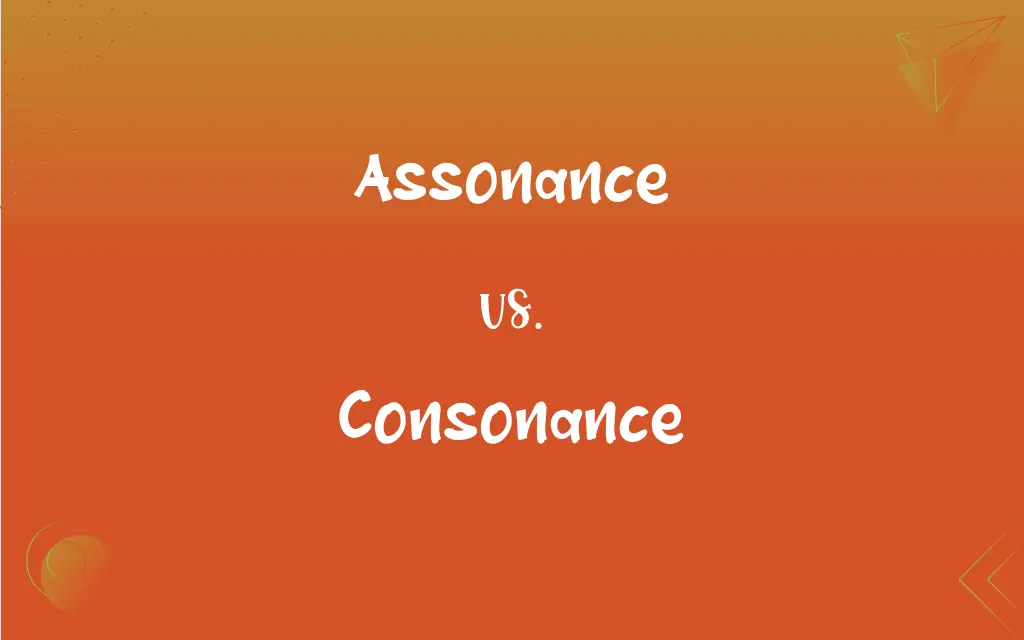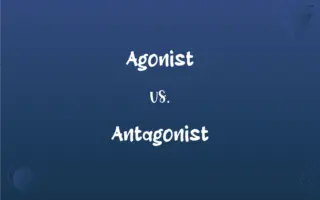Assonance vs. Consonance: What's the Difference?
Edited by Aimie Carlson || By Harlon Moss || Updated on October 14, 2023
Assonance is the repetition of vowel sounds in nearby words; consonance is the repetition of consonant sounds at the end or middle of words.

Key Differences
Assonance and consonance are poetic devices that involve repetition of sounds in words. Assonance focuses on repeating vowel sounds within a line or adjacent lines of poetry. This repetition can help to create a rhythm or mood in the poem. Consonance, on the other hand, is about repeating consonant sounds. This can occur at the end, beginning, or middle of words.
Assonance and consonance both contribute to the sonic quality of a piece of literature. While assonance emphasizes the 'internal' sounds of words, often evoking a particular emotion or setting a tone, consonance leans towards creating a resonance through repeated consonant sounds. Both can be subtle, yet they significantly influence the reader's auditory experience.
The use of assonance and consonance can be found in both poetry and prose. Assonance might lend a lyrical quality to the text, making it sound more melodic. Consonance, by contrast, can provide a rhythmic beat or cadence, sometimes emphasizing particular words or ideas in the text.
While assonance and consonance are both about repetition of sounds, they differ in the specific sounds they focus on. Assonance's reliance on vowel sounds can make text sound open or elongated, while consonance's emphasis on consonants can make the language sound sharper or more staccato. Both play crucial roles in shaping the soundscape of a literary piece.
Comparison Chart
Sound Focus
Vowel sounds
Consonant sounds
ADVERTISEMENT
Placement in Words
Usually internal
Beginning, middle, or end
Function
Creates rhythm or mood
Provides rhythmic beat or emphasizes
Usage
More melodic and lyrical
Adds cadence and sharpness
Example
"The cat sat on the mat."
"Blank and think" or "Strong and string."
Assonance and Consonance Definitions
Assonance
A resonance of vowels in non-rhyming words.
Hear the mellow wedding bells.
ADVERTISEMENT
Consonance
Recurring similar consonant sounds, not limited to just the beginnings of words.
The pitter-patter of little feet.
Assonance
A poetic device using repeated vowel sounds.
The fleet feet sweep by sleeping geese.
Consonance
The repetition of consonant sounds in words.
She sells sea shells by the sea shore.
Assonance
A repetition of vowel sounds in close words.
The light of the night was bright.
Consonance
A sound device involving repetition of consonant sounds for rhythm or emphasis.
Windy winter nights are the coldest.
Assonance
The recurrence of similar sounds in poetry or prose.
The rain in Spain stays mainly in the plain.
Consonance
A poetic technique of sound repetition in middle or end positions of words.
Rustling of leaves; the whispers of trees.
Assonance
The echoing of vowels in nearby words.
Go and mow the lawn.
Consonance
The echoing of consonants within a line or sentence.
Mammals named Sam are clammy.
Assonance
Resemblance of sound, especially of the vowel sounds in words, as in
"that dolphin-torn, that gong-tormented sea" (William Butler Yeats).
Consonance
Agreement; harmony; accord.
Assonance
The repetition of identical or similar vowel sounds, especially in stressed syllables, with changes in the intervening consonants, as in the phrase tilting at windmills.
Consonance
Close correspondence of sounds.
FAQs
Is assonance similar to alliteration?
Yes, but while alliteration involves the repetition of initial consonant sounds, assonance involves vowel sounds.
Why is assonance used?
It is used to create rhythm, establish a mood, and draw attention to certain words or phrases.
What is the purpose of using consonance?
It creates rhythm, aids memorability, and can convey specific emotions or meanings.
What is assonance?
Assonance is the repetition of vowel sounds within nearby words, typically in a line of poetry.
Can assonance be found in prose?
Yes, assonance can be found in both prose and poetry.
Can assonance occur in the middle of words?
Yes, assonance can occur anywhere within words.
What is an example of assonance?
"Hear the mellow wedding bells" by Edgar Allan Poe.
How does consonance differ from assonance?
Consonance involves repeated consonant sounds, while assonance involves repeated vowel sounds.
Does consonance impact the sound of prose or poetry?
Yes, it can significantly affect the rhythm and aesthetic quality of the text.
Can assonance be unintentional?
Yes, it can occur naturally without a deliberate attempt.
Is assonance common in specific literary forms?
Yes, it's especially prevalent in poetry, lyrics, and speeches.
How is consonance different from alliteration?
Alliteration refers to the repetition of initial consonant sounds, while consonance can occur at any position in words.
What is an example of consonance?
"She sells sea-shells by the sea-shore."
How do writers choose where to use consonance?
Writers might use consonance to draw attention to specific words, create a rhythm, or evoke a particular mood or emotion.
Does assonance need to involve adjacent words?
No, the words simply need to be close enough together for the repetition to be noticeable.
Can consonance appear at the beginning of words?
Typically, no— that is generally considered alliteration.
Does consonance only occur in poetry?
No, it can be found in prose, poetry, and other forms of text.
How is assonance different from rhyme?
Rhyme involves the repetition of both vowel and consonant sounds, usually at the end of words, while assonance only involves vowel sounds.
What is consonance?
Consonance is the repetition of consonant sounds typically at the end or in the middle of words in close proximity.
Can consonance be found in everyday language?
Yes, it often appears in common phrases, idioms, and slang.
About Author
Written by
Harlon MossHarlon is a seasoned quality moderator and accomplished content writer for Difference Wiki. An alumnus of the prestigious University of California, he earned his degree in Computer Science. Leveraging his academic background, Harlon brings a meticulous and informed perspective to his work, ensuring content accuracy and excellence.
Edited by
Aimie CarlsonAimie Carlson, holding a master's degree in English literature, is a fervent English language enthusiast. She lends her writing talents to Difference Wiki, a prominent website that specializes in comparisons, offering readers insightful analyses that both captivate and inform.
































































